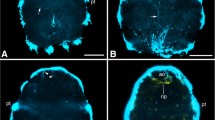Summary
Ultrastructural observations on the statocysts of the prosobranch gastropod Pomacea paludosa are reported in this paper.
-
1.
The static nerve consists of a great number of naked axons with a diameter of 0.2–0.5 μm. Several axons are joined together to bundles by glia cells (Fig. 1).
-
2.
The epithelium of the statocyst contains 2500–3000 hair (= sense) cells, each with an area of at most 75 μm2 (Fig. 2). This great number of hair cells is compared with the number of receptor cells in other gastropod statocysts.
-
3.
The hair cells are surrounded by smaller supporting cells. The significance of the interlacing of hair and supporting cells and of the possible contact between hair cells is discussed.
-
4.
Supporting cells possess microvilli and sometimes one modified cilium (Fig. 5). The hair cells bear microvilli and 30–40 cilia. These cilia have the typical 9+2 arrangement of the filaments, striated roots to one side of the basal body and a basal foot to the other (Fig. 3).
-
5.
For each sense cell and even for larger areas of the statocyst wall the basal feet point nearly in the same direction (Fig. 4). Hence it is suggested (a) a directional sensitivity for each hair cell and (b) a correlation between the areas of same polarisation and the “groups” of nerve fibers.
-
6.
Different types of vesicles in the nerve layer of the cyst wall (Fig. 6) and stimulation experiments give some evidence for an efferent innervation of the statocysts.
Similar content being viewed by others
References
Baecker, R.: Die Mikromorphologie von Helix pomatia und einigen anderen Stylommatophoren. Ergebn. Anat. Entwickl.-Gesch. 29, 449–585 (1932).
Barber, V. C.: The fine structure of the statocyst of Octopus vulgaris. Z. Zellforsch. 70, 91–107 (1966).
Barber, V. C.: The structure of mollusc statocysts, with particular reference to cephalopods. Symp. Zool. Soc. Lond. 23, 37–62 (1968).
Barber, V. C., Dilly, P. N.: Some aspects of the fine structure of the statocysts of the molluscs Pecten and Pterotrachea. Z. Zellforsch. 94, 462–478 (1969).
Beck, K.: Anatomie deutscher Bulimus-Arten. Jena. Z. Naturw. 48, 187–262 (1912).
Bouvier, E. L.: Système nerveux des Prosobranches. Ann. des Sci. nat. 7e Série (1887).
Coggeshall, R. E.: A fine structural analysis of the statocyst in Aplysia californica. J. Morph. 127, 113–132 (1969).
Dijkgraaf, S., Hessels, H. G. A.: Über Bau und Funktion der Statocyste bei der Schnecke Aplysia limacina. Z. vergl. Physiol. 62, 38–60 (1969).
Fawcett, D. W., Porter, K. R.: A study of the fine structure of ciliated epithelia. J. Morph. 94, 221–282 (1954).
Flock, Å, Duvall, A. J.: The ultrastructure of the kinocilium of the sensory cells in the inner ear and lateral line organs. J. Cell Biol. 25, 1–8 (1965).
Geuze, J. J.: Observations on the function and structure of the statocysts of Lymnaea stagnalis. Netherl. J. Zool. 18, 155–204 (1968).
Giesen, M., Klinke, R.: Die Richtcharakteristik primärer Afferenzen des Otolithenorgans bei intakter efferenter Innervation. Acta oto-laryng. (Stockh.) 67, 49–56 (1969).
Graziadei, P.: Electron microscopy of some primary receptors in the sucker of Octopus vulgaris. Z. Zellforsch. 64, 510–522 (1964).
Kolmer, W.: Bau der statischen Organe. In: Handbuch der normalen und pathologischen Physiologie Hrsg. A. Bethe, Bd. 11. Berlin: Springer 1926.
Laverack, M. S.: On superficial receptors. Symp. Zool. Soc. Lond. 23, 299–326 (1968).
Lowenstein, O., Osborne, M. P., Thornhill, R. A.: The anatomy and ultrastructure of the labyrinth of the lamprey (Lampetra fluviatilis L.). Proc. roy. Soc. B 170, 113–134 (1968).
Lowenstein, O., Wersäll, J.: Functional interpretation of the electron microscopic structure of the sensory hairs in the cristae of the elasmobranch Raja clavata in terms of directional sensitivity. Nature (Lond.) 184, 1807–1808 (1959).
Pfeil, E.: Die Statocyste von Helix pomatia L. Z. wiss. Zool. 119, 79–113 (1922).
Quattrini, D.: Osservazioni preliminari sulla ultrastruttura delle statocisti dei mollusci gasteropodi polmonati. Boll. Soc. ital. Biol. sper. 43, 785–786 (1967).
Schmidt, W.: Untersuchungen über die Statocysten unserer einheimischen Schnecken. Jena. Z. Naturw. 48, 515–562 (1912).
Stockem, W., Komnick, H.: Erfahrungen mit der Styrol-Methacrylat-Einbettung als Routinemethode für die Licht- und Elektronenmikroskopie. Mikroskopie 26, 199–203 (1970).
Vinnikov, Y. A.: Rezeptor gravitazii. Evoluzia strukturnoj, zitochimitscheskoj i funktionalnoj organisazii. In: “Problemy kosmitscheskoj biologii” Vol. XII (ed. W. I. Tschernigovskij). Isdatelstvo “Nauka” Leningradskoje otdelenije, Leningrad 1971.
Vinnikov, Y. A., Gasenko, O. G., Bronstein, A. A., Tsirulis, T. P., Ivanov, V. P., Pyatkina, G. A.: Structural, cytochemical and functional organisation of statocysts of Cephalopoda. Symp. Neurobiol. Invertebr., Budapest 29–48 (1967).
Wolff, H. G.: Elektrische Antworten der Statonerven der Schnecken (Arion empiricorum und Helix pomatia) auf Drehreizung. Experientia (Basel) 24, 848–849 (1968).
Wolff, H. G.: Einige Ergebnisse zur Ultrastruktur der Statocysten von Limax maximus, Limax flavus und Arion empiricorum (Pulmonata). Z. Zellforsch. 100, 251–270 (1969).
Wolff, H. G.: Statocystenfunktion bei einigen Landpulmonaten (Gastropoda) (Verhaltensphysiologische und elektrophysiologische Untersuchungen). Z. vergl. Physiol. 69, 326–366 (1970a).
Wolff, H. G.: Efferente Aktivität in den Statonerven einiger Landpulmonaten (Gastropoda). Z. vergl. Physiol. 70, 401–409 (1970b).
Wolff, H. G.: Statische Orientierung bei Mollusken. Fortschr. Zool. 1972 (in press).
Author information
Authors and Affiliations
Additional information
This research was supported by a grant from the Deutsche Forschungsgemeinschaft given to H. G. Wolff.
The authors are greatly indebted to Professor F. Huber for his critical reading of the manuscript and to Dr. M. Zaretsky for correcting the English text.
Rights and permissions
About this article
Cite this article
Stahlschmidt, V., Wolff, H.G. The fine structure of the statocyst of the prosobranch mollusc Pomacea paludosa . Z.Zellforsch 133, 529–537 (1972). https://doi.org/10.1007/BF00307133
Received:
Issue Date:
DOI: https://doi.org/10.1007/BF00307133




